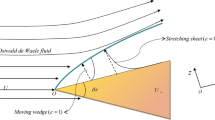Abstract
The classical boundary layer equations are a reduced form of the Navier-Stokes equations in which some terms have been omitted on certain order considerations. Euler’s equations are also another simplified form of the Navier-Stokes equations where viscosity is completely ignored. For two-dimensional (or axisymmetrical) motion the stream function ψ satisfies a fourth order non-linear differential equation if the full Navier-Stokes equations are taken into account; a fourth order linear differential equation for slow viscous motions; a third order non-linear equation according to Prandtl’s boundary layer assumptions; and a second order linear equation if the fluid is regarded inviscid. The reduction in order of the differential equation also necessitates some sacrifice of the boundary conditions. Thus in inviscid flow only the relative normal velocity on the solid must vanish at the wall, while in viscous flow both tangential and normal velocities must be zero. Linearization of the Navier-Stokes equations, either by regarding the fluid non-viscous or the motion to be so slow that the inertia terms can be completely or partially ignored, has resulted in only limited applications of the theory. The resistance to a solid moving through a real fluid is caused by the viscosity of the fluid, and if the parameter of viscosity is small, the viscous effects are confined only to a thin region surrounding the boundary—the boundary layer region.
Access this chapter
Tax calculation will be finalised at checkout
Purchases are for personal use only
Preview
Unable to display preview. Download preview PDF.
Similar content being viewed by others
References
Friedrichs, K. O.: Asymptotic phenomena in mathematical physics. Bul. Amer. Math. Soc. 61, 485–504 (1955) No. 6.
Görtler, H.: A new series for the calculation of steady laminar boundary layer flows. Jour. of Maths. and Mech. 6, 1–67 (1957) No. 1.
Howarth, L.: Steady laminar flow in the boundary layer near the surface of a cylinder in a stream. Aero. Res. Comm, R.M.No. 1632 (1935).
Blasius, H.: Zeit. Math. Physik. 56, 1–37 (1908).
Tani, I.: On the solution of laminar boundary layer equations. Jour. Phys. Soc. Japan, 4, 149–154 (1949).
Proudman, J.: Jour. Fluid Mech. Nov. 56, p. 505.
Wadhwa, Y. D.: Axisymmetrical viscous flow, unpublished thesis (see also ZAMM, Jan. 55, p. 69 ).
Kawaguti, M.: Critical Reynolds number for the flow past a sphere, Jour. Phys. Soc., Japan 10, 694–699 (1955) No. 8.
Lamb, H.: Hydrodynamics. 6th Edition, p. 244.
Lamb, H.: Hydrodynamics. 6th Edition, p. 614.
Author information
Authors and Affiliations
Editor information
Editors and Affiliations
Rights and permissions
Copyright information
© 1958 Springer-Verlag OHG., Berlin/Göttingen/Heidelberg
About this chapter
Cite this chapter
Seth, B.R. (1958). Synthetic method for boundary layer thickness. In: Görtler, H. (eds) Grenzschichtforschung / Boundary Layer Research. Internationale Union für theoretische und angewandte Mechanik / International Union of Theoretical and Applied Mechanics. Springer, Berlin, Heidelberg. https://doi.org/10.1007/978-3-642-45885-9_5
Download citation
DOI: https://doi.org/10.1007/978-3-642-45885-9_5
Publisher Name: Springer, Berlin, Heidelberg
Print ISBN: 978-3-540-02273-2
Online ISBN: 978-3-642-45885-9
eBook Packages: Springer Book Archive



